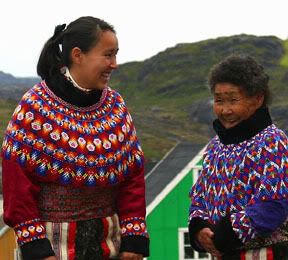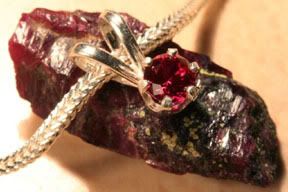Greg Valerio On The Unfolding Story of the Arctic Ruby: A Fairjewelry.org Breaking Story
Introduction:
Greg Valerio of Cred Jewellers is one of fair trade jewelry’s most passionate activists and advocates. Here, he tells the story of how from a personal perspective of how he is working to bring social justice to the indigenous people of Greenland. Special thanks to Greg for permission to print this article, which will appear in a UK publication in a few weeks.
~ Marc Choyt, Publisher
 I often ask myself the question ‘Why do I do jewellery?’ In many ways, it seems to be, the strangest of professions, especially for someone like myself whose principle motivation in life is the protection of human rights and the environment. I have always found it ironic that I should find myself in the jewellery sector that has no precedent, no history, no narrative, in a lot of ways, seemingly no intention of linking its product to the values that I stand for.
I often ask myself the question ‘Why do I do jewellery?’ In many ways, it seems to be, the strangest of professions, especially for someone like myself whose principle motivation in life is the protection of human rights and the environment. I have always found it ironic that I should find myself in the jewellery sector that has no precedent, no history, no narrative, in a lot of ways, seemingly no intention of linking its product to the values that I stand for.
Yet on a recent trip to Greenland in July of this year, I suddenly realized the reason why I am in this space is precisely because I care so deeply and passionately about these two above issues and it affords me the opportunity to make a real difference.
At the turn of the year I was invited to go to Greenland by a gemologist from America and an Inuit small-scale miner called Niels Madsen. Niels was the unfortunate victim on the 16th of August in 2007 along with 4 other colleagues of his; this incident is one of the reasons why we as jewellers, need to be so engaged in issues of human rights, cultural rights and environmental protection. Niels is an Inuit and a small-scale ruby miner.
The Greenlandic Constitution enshrines in law as a native of Greenland; which interestingly is still owned by the Danish Crown, (People forget that there are still European Colonial powers in the world and not all of North America is free from it) the right to hunt, mine and fish in the traditional ways that his ancestors would have done throughout countless generations.
Niels embodies the spirit of his people, unassuming, shy, softly spoken and deeply patient. He loves his work, loves collecting rubies, loves his children, loves his culture, loves his history, and has a dream of the future. And it is Niels and his colleagues’ dream that was so rudely and crassly interpreted by the Bureau for Minerals and Petroleum (BMP) at the behest of a Canadian Gemstone Mining company.
They had the Greenlandic police fly in helicopters, onto the mountainside, confiscate their rubies, accuse them of ruby smuggling, remove them from the mountainside, ban them from returning, threaten them with prison and criminalize their traditional way of life. All in contravention of their own Constitution.
As we walked through Greenland with Niels and friends, travelled by boat south to a typical fishing village (Fiskenaesset), climbed the mountains where they mined their rubies, learned how they mined their rubies, why they mined their rubies, shared their vision of what they would do with these stones like cutting and polishing, social enterprise initiatives for local communities during the winter months when it is to dark to do any work outside, feed their families with the proceeds and earn a decent living. I began to get a little taste of their dream. A dream they have dreamed then and one they still dream now.

(This ruby (pictured at right), valued at half a million dollars, has been illegally confiscated from its Inuit owner.)
I suddenly began to understand in a deeper way what my role as a social entrepreneur was and why I was working in this fantastic jewellery sector and to see the harmony of Niels’ role as the artisanal small-scale miner and how together we could bring tangible benefits to our world.
The relationship we were building was one of shared values, mutual respect and preservation of the environment, for the desire to earn a living and add to the common good. The desire not to be captured by an economic story that reduces everything and everyone to a figure on a balance sheet that only points to having exclusive corporate access to minerals of high value at any cost and at the expense of everyone else around you.
To underscore this point at the community meeting on Fair Trade Jewellery in Fiskenaesset an old lady stood up and made two simple points.

(Inuits are becoming more uncertain about their future as Global Warming expands across Greenland.)
“The Canadians have been coming here for years exploring for our rubies, when are they going to stop exploring?” and she followed this up with “The rubies belong to everyone, why will they not share them with us, after all they are our Rubies, not the Canadians!”
These two simple statements seemed to embody the core of the problem. On the one hand you have a culture that views nature and the environment as a gift for everyone, and a company whose philosophy is one of private wealth and ownership and views the environment as something to be owned and exploited. We have to choose what kind of jewellery we want to create.
The whole cycle of the relationship we shared with these people drove home to me like a silver bullet, why the jewellery trade has the potential to become a real force for social improvement as well as environmental protection. As business people, as a crafts people, as artists, as designers we are all 100% dependent on materials that are mined from the ground.
We have to employ and engender some of the finest elements of our shared humanity, to take these raw materials and create items of exquisite beauty. As for the process between the mineral from the ground and the item of beauty that will adorn someone’s body, that process must capture that spirit, the integrity, and those values from end to end. If my jewellery does not do this, then what I am selling is cheapened.
Human Rights and the Environment are signifiers to us of all that is good, decent and honest in our world. As jewellers, we cannot allow the pursuit of pure profit to continue to blindly ignore what is going on. One of my goals in the last 10 years has been to prove this point. We can bend our business to serve greater goals and a global common good and make a decent living. We are a truly global industry, from mine to retail, from the poorest and most marginalized people to the wealthiest and most powerful.
To conclude, Niels Madsen and his friends are currently fighting for the simple right to sell their rubies so they can feed their families. Also to have their confiscated collections returned to them. The authorities in Greenland that are an extension of the Danish Colonial Government have said they (Inuit) are not allowed to sell anything that is precious or expensive.
Only foreign mining companies are allowed to make money from the sale of all precious metals and gems. This kind of apartheid has no place in the 21st century, no place in North America, no place in Europe, no place in the world. Therefore I would like to ask every reader of this article to support the small-scale miners of Greenland by signing an online petition that has been set up by the 16th August Union (the new Greenland small scale miners union). This will be sent to the premier of Greenland and to the Greenlandic Home Rule Parliament.
If this sounds like a campaign, it is, and I am confident that if the UK jewellery sector supports it, we will all be able to purchase Greenland Rubies mined, cut and polished by our Inuit friends and bring real benefits to the Greenland Economy.
For more information please contact Greg Valerio at (greg.valerio1@virgin.net)


